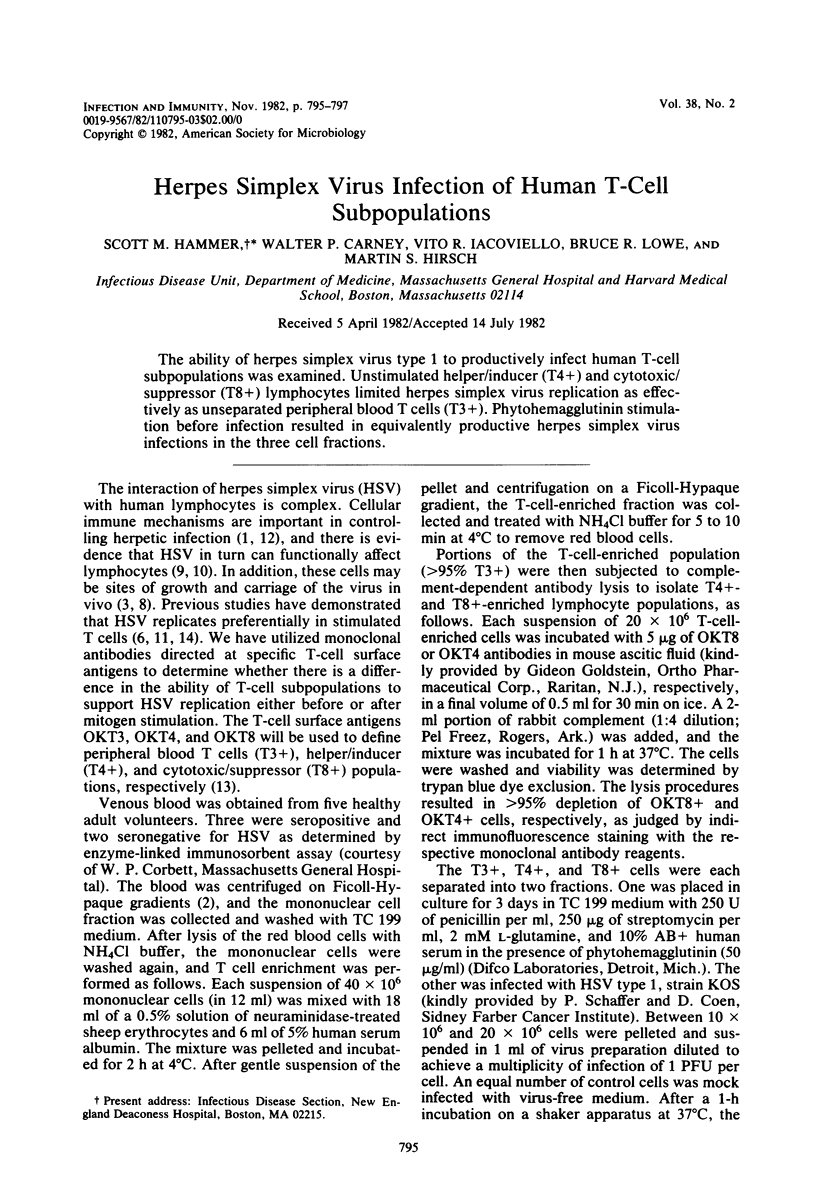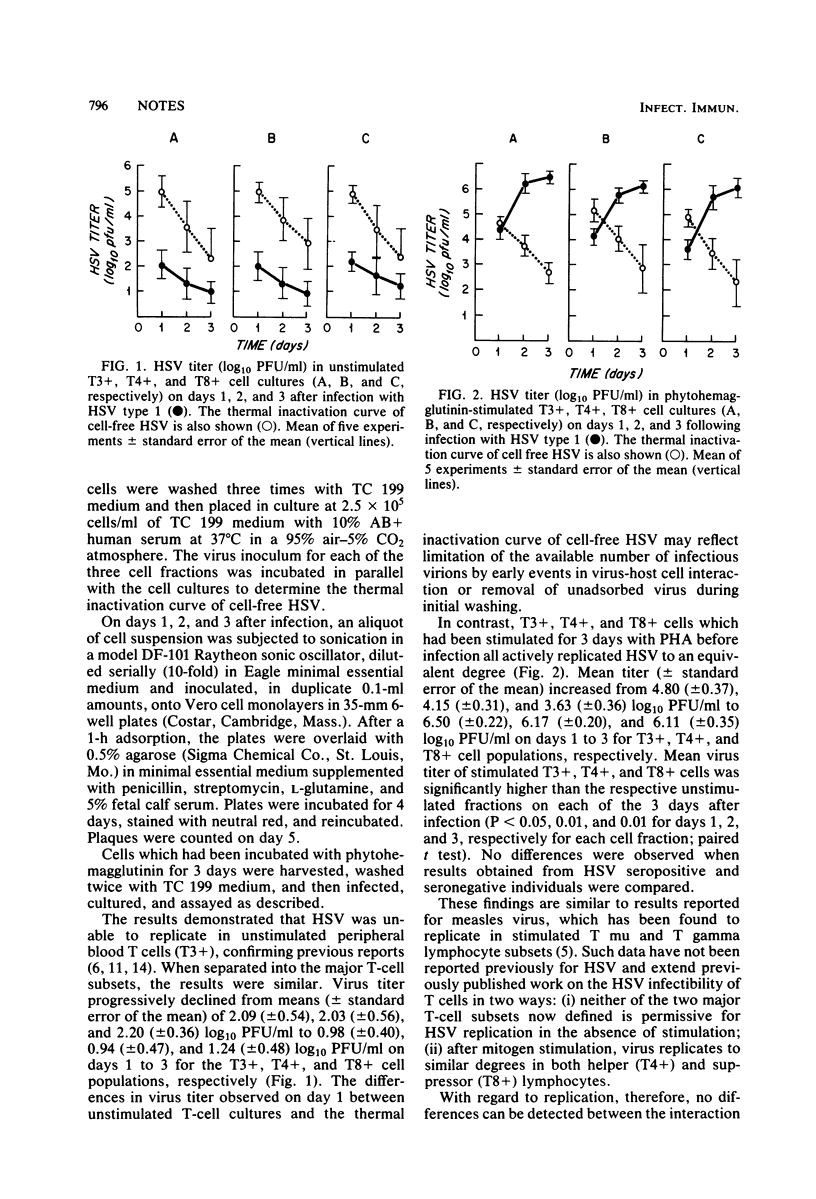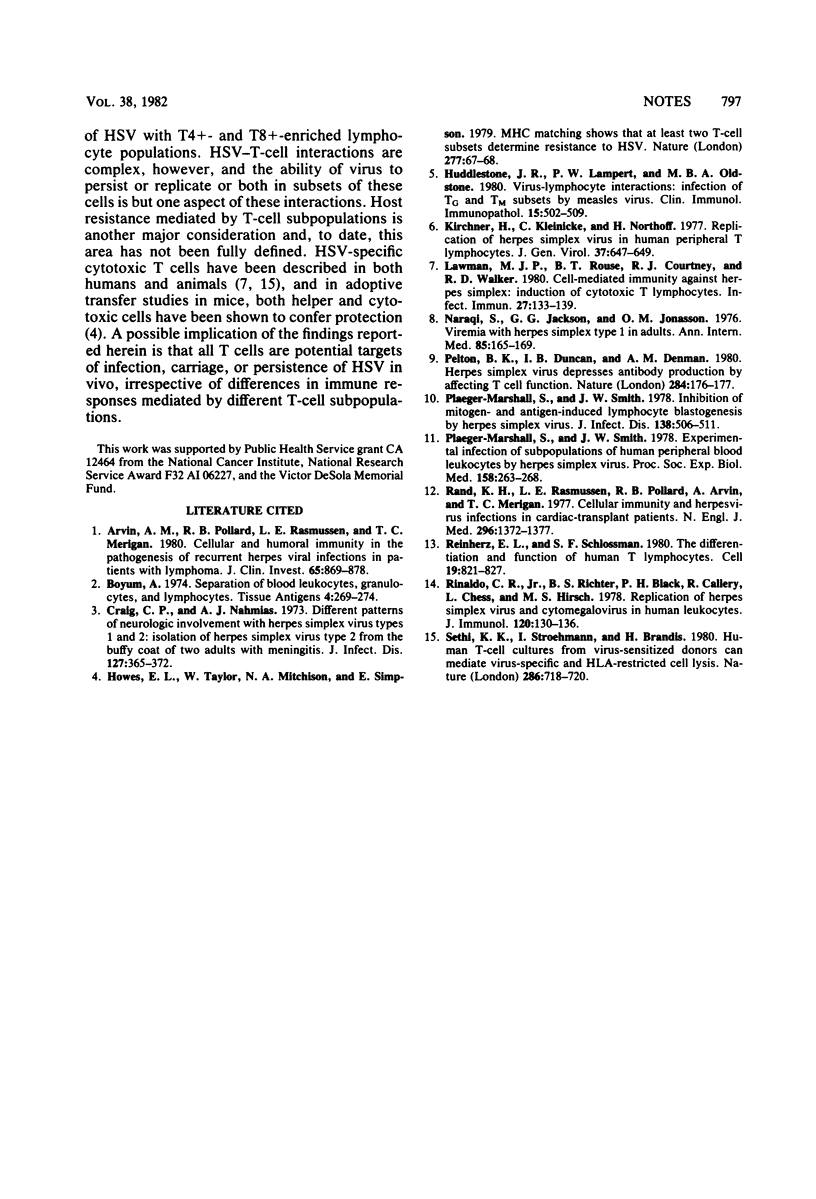Abstract
The ability of herpes simplex virus type 1 to productively infect human T-cell subpopulations was examined. Unstimulated helper/inducer (T4+) and cytotoxic/suppressor (T8+) lymphocytes limited herpes simplex virus replication as effectively as unseparated peripheral blood T cells (T3+). Phytohemagglutinin stimulation before infection resulted in equivalently productive herpes simplex virus infections in the three cell fractions.
Full text
PDF


Selected References
These references are in PubMed. This may not be the complete list of references from this article.
- Arvin A. M., Pollard R. B., Rasmussen L. E., Merigan T. C. Cellular and humoral immunity in the pathogenesis of recurrent herpes viral infections in patients with lymphoma. J Clin Invest. 1980 Apr;65(4):869–878. doi: 10.1172/JCI109739. [DOI] [PMC free article] [PubMed] [Google Scholar]
- Boyum A. Separation of blood leucocytes, granulocytes and lymphocytes. Tissue Antigens. 1974;4(4):269–274. [PubMed] [Google Scholar]
- Craig C. P., Nahmias A. J. Different patterns of neurologic involvement with herpes simplex virus types 1 and 2: isolation of herpes simplex virus type 2 from the buffy coat of two adults with meningitis. J Infect Dis. 1973 Apr;127(4):365–372. doi: 10.1093/infdis/127.4.365. [DOI] [PubMed] [Google Scholar]
- Howes E. L., Taylor W., Mitchison N. A., Simpson E. MHC matching shows that at least two T-cell subsets determine resistance to HSV. Nature. 1979 Jan 4;277(5691):66–68. doi: 10.1038/277067a0. [DOI] [PubMed] [Google Scholar]
- Huddlestone J. R., Lampert P. W., Oldstone M. B. Virus-lymphocyte interactions: infection of Tg and Tm subsets by measles virus. Clin Immunol Immunopathol. 1980 Mar;15(3):502–509. doi: 10.1016/0090-1229(80)90062-8. [DOI] [PubMed] [Google Scholar]
- Lawman M. J., Rouse B. T., Courtney R. J., Walker R. D. Cell-mediated immunity against herpes simplex induction of cytotoxic T lymphocytes. Infect Immun. 1980 Jan;27(1):133–139. doi: 10.1128/iai.27.1.133-139.1980. [DOI] [PMC free article] [PubMed] [Google Scholar]
- Naraqi S., Jackson G. G., Jonasson O. M. Viremia with herpes simplex type 1 in adults. Four nonfatal cases, one with features of chicken pox. Ann Intern Med. 1976 Aug;85(2):165–169. doi: 10.7326/0003-4819-85-2-165. [DOI] [PubMed] [Google Scholar]
- Pelton B. K., Duncan I. B., Denman A. M. Herpes simplex virus depresses antibody production by affecting T-cell function. Nature. 1980 Mar 13;284(5752):176–177. doi: 10.1038/284176a0. [DOI] [PubMed] [Google Scholar]
- Plaeger-Marshall S., Smith J. W. Experimental infection of subpopulations of human peripheral blood leukocytes by herpes simplex virus. Proc Soc Exp Biol Med. 1978 Jun;158(2):263–268. doi: 10.3181/00379727-158-40185. [DOI] [PubMed] [Google Scholar]
- Plaeger-Marshall S., Smith J. W. Inhibition of mitogen- and antigen-induced lymphocyte blastogenesis by herpes simplex virus. J Infect Dis. 1978 Oct;138(4):506–511. doi: 10.1093/infdis/138.4.506. [DOI] [PubMed] [Google Scholar]
- Rand K. H., Rasmussen L. E., Pollard R. B., Arvin A., Merigan T. C. Cellular immunity and herpesvirus infections in cardiac-transplant patients. N Engl J Med. 1977 Jun 16;296(24):1372–1377. doi: 10.1056/NEJM197706162962402. [DOI] [PubMed] [Google Scholar]
- Reinherz E. L., Schlossman S. F. The differentiation and function of human T lymphocytes. Cell. 1980 Apr;19(4):821–827. doi: 10.1016/0092-8674(80)90072-0. [DOI] [PubMed] [Google Scholar]
- Rinaldo C. R., Jr, Richter B. S., Black P. H., Callery R., Chess L., Hirsch M. S. Replication of herpes simplex virus and cytomegalovirus in human leukocytes. J Immunol. 1978 Jan;120(1):130–136. [PubMed] [Google Scholar]
- Sethi K. K., Stroehmann I., Brandis H. Human T-cell cultures from virus-sensitized donors can mediate virus-specific and HLA-restricted cell lysis. Nature. 1980 Aug 14;286(5774):718–720. doi: 10.1038/286718a0. [DOI] [PubMed] [Google Scholar]


